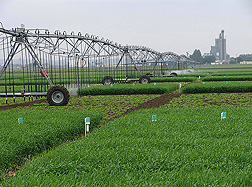This page has been archived and is being provided for reference purposes only. The page is no longer being updated, and therefore, links on the page may be invalid.
Read the magazine story to find out more. |
|
|
New Irrigation System Asks "Can You Hear Me Now?"
By Erin PeabodyJuly 12, 2007
Is it true, as some "green thumbers" claim, that talking to our plants really helps them thrive?
If you ask Agricultural Research Service (ARS) scientist Robert Evans—who's built a state- of-the-art irrigation system that uses the latest in wireless technology for "communicating" with his crops—the answer is probably "yes."
An agricultural engineer, Evans isn't so much talking as listening to plants—thanks to the prototype irrigation system he and colleagues have developed, which comprises Bluetooth technology, sensors, weather stations and traditional irrigation equipment.
Evans works at the ARS Northern Plains Agricultural Research Laboratory in Sidney, Mont. He and ARS research associate James Kim built the novel irrigation system with two goals in mind: to increase crop survivability and save precious water and fertilizer.
So just how does their technology work? Scattered across a field are sensors that, like little thermometers, constantly take the temperature of the plants and soil around them. Bluetooth enables the sensors to wirelessly transmit data back to the base station, which then instructs individual sprinkler heads exactly how much water to dole out.
The new system washes away one of the biggest challenges facing irrigators: the endless variation in soil types that can exist across a field.
Take, for instance, clay and sandy soils, which have nearly opposite behaviors: one practically repels water, while the other sucks it in readily. But in a given field, these soils may be close neighbors, leading to an inevitable underwatering or overwatering scenario.
However, Evans and Kim's system treats a field not as a "one-size-fits-all" soil zone, but as a collection of smaller, individual plots, each with its own set of organic idiosyncrasies.
According to Evans, innovations such as these are necessary if society is to better manage its diminishing freshwater supplies—an estimated 60 percent of which are currently used for irrigation worldwide.
Read more in the current issue of Agricultural Research magazine.
ARS is the U.S. Department of Agriculture's chief scientific research agency.

